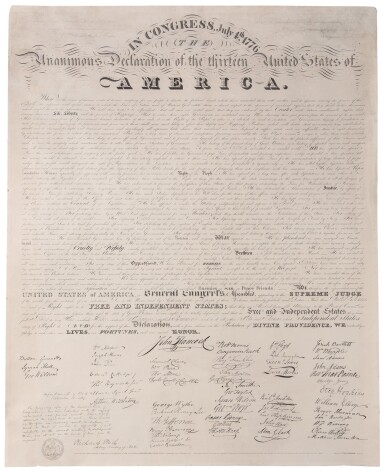DECLARATION OF INDEPENDENCE]. In Congress, July 4, 1776. The Unanimous Declaration of the Thirteen United States of America. When in the Course of Human Events... [Washington, D.C., engraved by W.I. Stone, 1823, printed by Peter Force, 1848]. Folio broadside (30¾ x 25 7/8 in.), slight browning along right-hand edge, a few discreet marginal repairs, the paper with no evidence of folding, in fine condition. Archivally matted and enclosed in a museum-quality giltwood frame. PETER FORCE'S 1848 PRINTING OF THE DECLARATION OF INDEPENDENCE FROM THE W.J. STONE 1823 COPPERPLATE, ON FINE RICE PAPER, UNFOLDED. Twenty-five years after Stone's elaborate engraved facsimile on parchment had been printed and distributed, Peter Force (1790-1868) utilized Stone's surviving copperplate to print impressions of the facsimile on fine rice paper with a color tone quite similar to parchment. These were intended for inclusion in Force's American Archives , a planned monumental compilation of important original American documents, prepared at the instigation of Congress. Force carefully deleted Stone's original 1823 imprint in the upper portion of the plate, and added an new imprint ("W.J. Stone sc. Washington.") in the lower left. A total of 1500 copies of American Archives were authorized by Congress, but in the end, subscriptions for the elaborate 9-volume collection were disappointing, and ultimately far fewer copies (perhaps only 500) were issued. Since copies of Force's Declaration exist both with and without folds, it is probable that a few copies like the present had never been folded for binding. The unfolded copies are less common and are definitely aesthetically more appealing.
DECLARATION OF INDEPENDENCE]. In Congress, July 4, 1776. The Unanimous Declaration of the Thirteen United States of America. When in the Course of Human Events... [Washington, D.C., engraved by W.I. Stone, 1823, printed by Peter Force, 1848]. Folio broadside (30¾ x 25 7/8 in.), slight browning along right-hand edge, a few discreet marginal repairs, the paper with no evidence of folding, in fine condition. Archivally matted and enclosed in a museum-quality giltwood frame. PETER FORCE'S 1848 PRINTING OF THE DECLARATION OF INDEPENDENCE FROM THE W.J. STONE 1823 COPPERPLATE, ON FINE RICE PAPER, UNFOLDED. Twenty-five years after Stone's elaborate engraved facsimile on parchment had been printed and distributed, Peter Force (1790-1868) utilized Stone's surviving copperplate to print impressions of the facsimile on fine rice paper with a color tone quite similar to parchment. These were intended for inclusion in Force's American Archives , a planned monumental compilation of important original American documents, prepared at the instigation of Congress. Force carefully deleted Stone's original 1823 imprint in the upper portion of the plate, and added an new imprint ("W.J. Stone sc. Washington.") in the lower left. A total of 1500 copies of American Archives were authorized by Congress, but in the end, subscriptions for the elaborate 9-volume collection were disappointing, and ultimately far fewer copies (perhaps only 500) were issued. Since copies of Force's Declaration exist both with and without folds, it is probable that a few copies like the present had never been folded for binding. The unfolded copies are less common and are definitely aesthetically more appealing.







.jpg)
.jpg)



.jpg)


Testen Sie LotSearch und seine Premium-Features 7 Tage - ohne Kosten!
Lassen Sie sich automatisch über neue Objekte in kommenden Auktionen benachrichtigen.
Suchauftrag anlegen